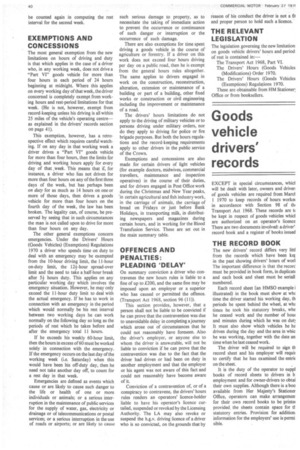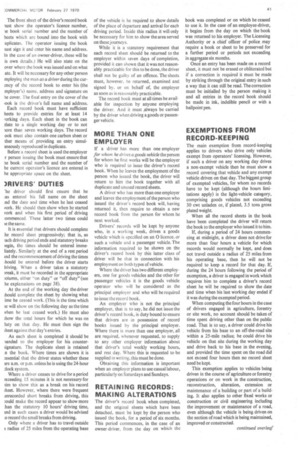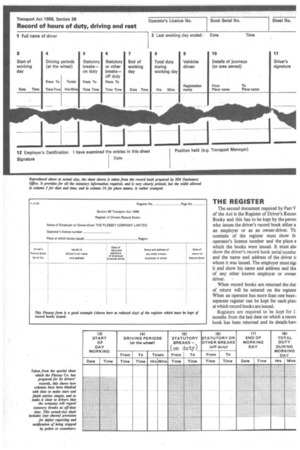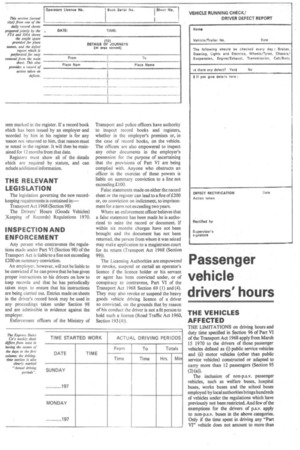Goods vehicle drivers' records
Page 42

Page 43

Page 44

Page 45

If you've noticed an error in this article please click here to report it so we can fix it.
EXCEPT in special circumstances, whici will be dealt with later, owners and driver: of goods vehicles are required from Marcl 1 1970 to keep records of hours worke( in accordance with Section 98 of thi Transport Act 1968. These records are tc be kept in respect of goods vehicles whicl are authorized on an operator's licence There are two documents involved: a driver': record book and a register of books issued
THE RECORD BOOK
The new drivers' record differs very littl from the records which have been ker in the past showing drivers' hours of worl The important difference is that the recott must be provided in book form, in duplicat and each book and sheet must be serial! numbered.
Each record sheet (an HMSO example i illustrated) in the book must show at whl. time the driver started his working day, th periods he spent behind the wheel, at whn. times he took his statutory breaks, whe he ceased work and the number of how and minutes during which he was on dut] It must also show which vehicles he ha driven during the day and the area in whic he was working, together with the date an time when he last ceased work.
The driver will be required to sign th record sheet and his employer will requit to certify that he has examined the entrk on the sheet.
It is the duty of the operator to suppl books of record sheets to drivers in h employment and for owner-drivers to obtai their own supplies. Although there is a boo available from Her Majesty's Stationer Office, operators can make arrangemen for their own record books to be printei provided, the sheets contain space for tl statutory entries. Provision for addition. information for the employers' use is permi sible. The front sheet of the driver's record book lust show the operator's licence number, le book serial number and the number of beets which are bound into the book with uplicates. The operator issuing the book lust sign it and enter his name and address. hi the case of an owner-driver, these will be is own details.) He will also state on the over where the book was issued and on what ate. It will be necessary for any other person mploying the man as a driver during the curency of the record book to enter his (the mployer's) name, address and signature on Lie cover. The final entry on the cover of the look is the driver's full name and address.
Each record book must have sufficient heets to provide entries for at least 14 forking days. Each sheet in the book can elate to a single working day or to not lore than seven working days. The record ,00k must also contain one carbon sheet or ther means of providing an entry simulaneously reproduced in duplicate.
Before a record sheet is used the employer ■ 1' person issuing the book must ensure that Lie book serial number and the number of he current operator's licence are entered in he appropriate space on the sheet.
)RIVERS' DUTIES
he driver should first ensure that he Las entered his full name on the sheet aid the date and time when he last ceased vork. He should then show when he started vork and when his first period of driving :ommenced. These latter two times could ,e the same.
• It is essential that drivers should complete he record sheet progressively; that is, as :ach driving period ends and statutory breaks )egin, the times should be entered imrneliately. Similarly at the end of a rest period Ind the recommencement of driving the times ihould be entered before the driver starts iriving. When a driver takes a statutory mak, it must be recorded in the appropriate :olumn, either "on duty" or "off duty" (see he explanations on page 38).
At the end of the working day the driver :hould complete the sheet by showing what :hue he ceased work. (This is the time which le will show on the following day as the time vhen he last ceased work.) He must also ;how the total hours for which he was on luty on that day. He must then sign the ;heet against that day's entries.
As each sheet is completed it should be landed to the employer for his counter;ignature. The duplicate sheet is retained n the book. Where times are shown it is :ssential that the driver states whether these ire a.m. or p.m. unless he is using the 24-hour :lock system.
Where a driver ceases to drive for a period :.xceeding 15 minutes it is not necessary for iirn to show this as a break on his record ;heet. However, where there were frequent Jnrecorded short breaks from driving, this :ould make the record appear to show more han the statutory 10 hours' driving time, ind in such cases a driver would be advised :o record the small breaks from driving.
Only where a driver has to travel outside radius of 25 miles from the operating base of the vehicle is he required to show details of the place of departure and arrival for each driving period. Inside this radius it will only be necessary for him to show the area served on these journeys.
While it is a statutory requirement that each record sheet should be returned to the employer within seven days of completion, provided it can shown that it was not reasonably practicable for this to be done, the driver shall not be guilty of an offence. The sheets must, however, be returned, examined and signed by. or on behalf of, the employer as soon as is reasonably practicable.
The record book must at all times be available for inspection by anyone employing the driver. And it must always be carried by the driver when driving a goods or passenger vehicle.
MORE THAN ONE EMPLOYER
If a driver has more than one employer for whom he drives a goods vehicle the person for whom he first works will be the employer who is required to issue the driver's record book. When he leaves the employment of the person who issued the book, the driver will return to him the book together with all duplicate and unused record sheets.
A driver who has more than one employer and leaves the employment of the person who issued the driver's record book will, having returned it, then require to obtain a new record book from the person for whom he next worked.
Drivers' records will be kept by anyone who, in a working week, drives a goods vehicle which is specified on an 0 licence, or such a vehicle and a passenger vehicle. The information required to be shown on the driver's record book by this latter class of driver will be that in connection with his employment on both types of vehicle.
Where the driver has two different employers, one for goods vehicles and the other for passenger vehicles it is the goods vehicle operator who will be considered as the principal employer and who will be required to issue the record book.
An employer who is not the principal employer, that is to say, he did not issue the driver's record book, is duty bound to ensure that drivers are in possession of record books issued by the principal employer. Where there is more than one employer, all are required, whenever requested, to supply to any other employer information about that driver's total weekly working hours, and rest day. Where this is requested to be supplied in writing, this must be done.
Obtaining this information is important when an employer plans to use casual labour, particularly on Saturdays and Sundays.
RETAINING RECORDS: MAKING ALTERATIONS
The driver's record book when completed, and the original sheets which have been detached, must be kept by the person who issued the book, for a period of six months. This period commences, in the case of an owner-driver, from the day on which the book was completed or on which he ceased to use it. In the case of an employee-driver, it begins from the day on which the book was returned to his employer. The Licensing Authority or a chief officer of police may require a book or sheet to be preserved for a further period or periods not exceeding in aggregate six months.
Once an entry has been made on a record sheet, it must not be erased or obliterated but if a correction is required it must be made by striking through the original entry in such a way that it can still be read. The correction must be initialled by the person making it and all entries in the record book should be made in ink, indelible pencil or with a ballpoint pen.
EXEMPTIONS FROM RECORD-KEEPING
The main exemption from record-keeping applies to drivers who drive only vehicles exempt from operators' licensing. However, if such a driver on any working day drives a non-exempt vehicle then he must show a record covering that vehicle and any exempt vehicle driven on that day. The biggest group of exempted vehicles, for whom no records have to be kept (although the hours limitations apply) is the light-vehicle category, comprising goods vehicles not exceeding 30 cwt unladen or, if plated, 3.5 tons gross plated weight.
When all the record sheets in the book have been completed the driver will return the book to the employer who issued it to him.
If, during a period of 24 hours commen cing at midnight, a driver does not drive for more than four hours a vehicle for which records would normally be kept, and does not travel outside a radius of 25 miles from his operating base, then he will not be required to keep a record for that day. If, during the 24 'hours following the period of exemption, a driver is engaged in work which requires him to complete a driver's record sheet he will be required to show the date and time when his last Working day ended if it was during the exempted period.
When computing the four hours in the case of drivers engaged in agriculture, forestry or site work, no account should be taken of time spent driving other than on the public road. That is to say, a driver could drive his vehicle from his base to an off-the-road site within a 25-mile radius; he could drive his vehicle on that site during the working day and drive back to his base in the evening, and provided the time spent on the road did not exceed four hours then no record sheet need be kept.
This exemption applies to vehicles being driven in the course of agriculture or forestry operations or on work in the construction, reconstruction, alteration, extension or maintenance of a building or part of a build ing. It also applies to other fixed works or construction or civil engineering including the improvement or• maintenance of a road, even although the vehicle is being driven on the section of road which is being maintained, improved or constructed.
THE REGISTER
The second document required by Part V of the Act is the Register of Driver's Recon Books and this has to be kept by the persoi who issues the driver's record book either a an employer or as an owner-driver. Th• contents of the register must show tb. operator's licence number and the place a which the books were issued. It must alsi show the driver's record book serial numbe: and the name and address of the driver ti whom it was issued. The employer must sip it and show his name and address and tha of any other known employer or owner driver.
When record books are returned the dat of return will be entered on the register When an operator has more than one base separate register can be kept for each piaci at which record books are issued.
Registers are required to be kept for 1: months from the last date on which a recorr book has been returned and its details havi
Jeen marked in the register. If a record book vhich has been issued by an employer and -ecorded by him in his register is for any .eason not returned to him, that reason must )e noted in the register. It will then be main.ained for 12 months from that date.
Registers must show all of the details vhich are required by statute, and can nclude additional information.
THE RELEVANT LEGISLATION
The legislation governing the new recordkeeping requirements is contained in:— Transport Act 1968 (Section 98) The Drivers' Hours (Goods Vehicles) Keeping of Records) Regulations 1970.
INSPECTION AND ENFORCEMENT
Any person who contravenes the regulations made under Part VI (Section 98) of the Transport Act is liable to a fine not exceeding £200 on summary conviction.
An employer, however, will not be liable to be convicted if he can prove that he has given proper instructions to his drivers on how to keep records and that he has periodically taken steps to ensure that his instructions are being carried out. Entries made on sheets in the driver's record book may be used in any proceedings taken under Section 98 and are admissible in evidence against the employer.
Enforcement officers of the Ministry of Transport and police officers have authority to inspect record books and registers, whether in the employer's premises or, in the case of record books, on the vehicle. The officers are also empowered to inspect any other documents in the employer's possession for the purpose of ascertaining that the provisions of Part VI are being complied with. Anyone who obstructs an officer in the exercise of these powers is liable on summary conviction to a fine not exceeding £100.
False statements made on either the record sheet or the register can lead to a fine of £200 or, on conviction on indictment, to imprisonment for a term not exceeding two years.
Where an enforcement officer believes that a false statement has been made he is authorized to seize the record or document. if within six months charges have not been brought and the document has not been returned, the person from whom it was seized may make application to a magistrates court for its return (Transport Act 1968 (Section 99)).
The Licensing Authorities are empowered to revoke, suspend or curtail an operator's licence if the licence holder or his servant or agent has been convicted under, or of conspiracy to contravene, Part VI of the Transport Act 1968 Section 69 (1) and (4). They may also revoke or suspend the heavy goods vehicle driving licence of a driver so convicted, on the grounds that by reason of his conduct the driver is not a fit person to hold such a licence (Road Traffic Act 1960, Section 193 (4)).




































































































